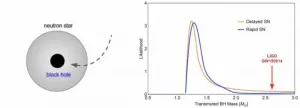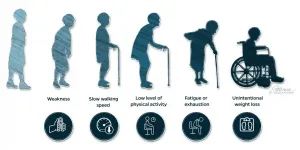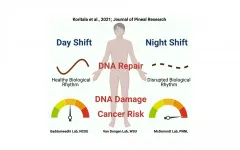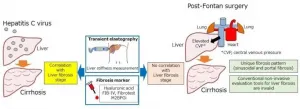INFORMATION:
This research was supported, in part, by Ford Motor Company as part of the Ford-MIT Alliance.
Paper: "Certifiable robustness to adversarial state uncertainty in deep reinforcement learning"
https://ieeexplore.ieee.org/document/9354500
Algorithm helps artificial intelligence systems dodge "adversarial" inputs
Method builds on gaming techniques to help autonomous vehicles navigate in the real world, where signals may be imperfect.
2021-03-08
(Press-News.org) In a perfect world, what you see is what you get. If this were the case, the job of artificial intelligence systems would be refreshingly straightforward.
Take collision avoidance systems in self-driving cars. If visual input to on-board cameras could be trusted entirely, an AI system could directly map that input to an appropriate action -- steer right, steer left, or continue straight -- to avoid hitting a pedestrian that its cameras see in the road.
But what if there's a glitch in the cameras that slightly shifts an image by a few pixels? If the car blindly trusted so-called "adversarial inputs," it might take unnecessary and potentially dangerous action.
A new deep-learning algorithm developed by MIT researchers is designed to help machines navigate in the real, imperfect world, by building a healthy "skepticism" of the measurements and inputs they receive.
The team combined a reinforcement-learning algorithm with a deep neural network, both used separately to train computers in playing video games like Go and chess, to build an approach they call CARRL, for Certified Adversarial Robustness for Deep Reinforcement Learning.
The researchers tested the approach in several scenarios, including a simulated collision-avoidance test and the video game Pong, and found that CARRL performed better -- avoiding collisions and winning more Pong games -- over standard machine-learning techniques, even in the face of uncertain, adversarial inputs.
"You often think of an adversary being someone who's hacking your computer, but it could also just be that your sensors are not great, or your measurements aren't perfect, which is often the case," says Michael Everett, a postdoc in MIT's Department of Aeronautics and Astronautics (AeroAstro). "Our approach helps to account for that imperfection and make a safe decision. In any safety-critical domain, this is an important approach to be thinking about."
Everett is the lead author of a study outlining the new approach, which appears in IEEE's Transactions on Neural Networks and Learning Systems. The study originated from MIT PhD student Björn Lütjens' master's thesis and was advised by MIT AeroAstro Professor Jonathan How.
Possible realities
To make AI systems robust against adversarial inputs, researchers have tried implementing defenses for supervised learning. Traditionally, a neural network is trained to associate specific labels or actions with given inputs. For instance, a neural network that is fed thousands of images labeled as cats, along with images labeled as houses and hot dogs, should correctly label a new image as a cat.
In robust AI systems, the same supervised-learning techniques could be tested with many slightly altered versions of the image. If the network lands on the same label -- cat -- for every image, there's a good chance that, altered or not, the image is indeed of a cat, and the network is robust to any adversarial influence.
But running through every possible image alteration is computationally exhaustive and difficult to apply successfully to time-sensitive tasks such as collision avoidance. Furthermore, existing methods also don't identify what label to use, or what action to take, if the network is less robust and labels some altered cat images as a house or a hotdog.
"In order to use neural networks in safety-critical scenarios, we had to find out how to take real-time decisions based on worst-case assumptions on these possible realities," Lütjens says.
The best reward
The team instead looked to build on reinforcement learning, another form of machine learning that does not require associating labeled inputs with outputs, but rather aims to reinforce certain actions in response to certain inputs, based on a resulting reward. This approach is typically used to train computers to play and win games such as chess and Go.
Reinforcement learning has mostly been applied to situations where inputs are assumed to be true. Everett and his colleagues say they are the first to bring "certifiable robustness" to uncertain, adversarial inputs in reinforcement learning.
Their approach, CARRL, uses an existing deep-reinforcement-learning algorithm to train a deep Q-network, or DQN -- a neural network with multiple layers that ultimately associates an input with a Q value, or level of reward.
The approach takes an input, such as an image with a single dot, and considers an adversarial influence, or a region around the dot where it actually might be instead. Every possible position of the dot within this region is fed through a DQN to find an associated action that would result in the most optimal worst-case reward, based on a technique developed by recent MIT graduate student Tsui-Wei "Lily" Weng PhD '20.
An adversarial world
In tests with the video game Pong, in which two players operate paddles on either side of a screen to pass a ball back and forth, the researchers introduced an "adversary" that pulled the ball slightly further down than it actually was. They found that CARRL won more games than standard techniques, as the adversary's influence grew.
"If we know that a measurement shouldn't be trusted exactly, and the ball could be anywhere within a certain region, then our approach tells the computer that it should put the paddle in the middle of that region, to make sure we hit the ball even in the worst-case deviation," Everett says.
The method was similarly robust in tests of collision avoidance, where the team simulated a blue and an orange agent attempting to switch positions without colliding. As the team perturbed the orange agent's observation of the blue agent's position, CARRL steered the orange agent around the other agent, taking a wider berth as the adversary grew stronger, and the blue agent's position became more uncertain.
There did come a point when CARRL became too conservative, causing the orange agent to assume the other agent could be anywhere in its vicinity, and in response completely avoid its destination. This extreme conservatism is useful, Everett says, because researchers can then use it as a limit to tune the algorithm's robustness. For instance, the algorithm might consider a smaller deviation, or region of uncertainty, that would still allow an agent to achieve a high reward and reach its destination.
In addition to overcoming imperfect sensors, Everett says CARRL may be a start to helping robots safely handle unpredictable interactions in the real world.
"People can be adversarial, like getting in front of a robot to block its sensors, or interacting with them, not necessarily with the best intentions," Everett says. "How can a robot think of all the things people might try to do, and try to avoid them? What sort of adversarial models do we want to defend against? That's something we're thinking about how to do."
ELSE PRESS RELEASES FROM THIS DATE:
Targeted immunotherapy could boost radiotherapy response
2021-03-08
Cancers that are resistant to radiotherapy could be rendered susceptible through treatment with immunotherapy, a new study suggests.
Researchers believe that manipulating bowel cancers based on their 'immune landscape' could unlock new ways to treat resistant tumours.
Cancers can evolve resistance to radiotherapy just as they do with drugs.
The new study found that profiling the immune landscape of cancers before therapy could identify patients who are likely to respond to radiotherapy off the bat, and others who might benefit from priming of their tumour with immunotherapy.
Scientists at The Institute of Cancer Research, London, in collaboration with the University of Leeds and The Francis Crick ...
Someone to watch over AI and keep it honest - and it's not the public!
2021-03-08
The public doesn't need to know how Artificial Intelligence works to trust it. They just need to know that someone with the necessary skillset is examining AI and has the authority to mete out sanctions if it causes or is likely to cause harm.
Dr Bran Knowles, a senior lecturer in data science at Lancaster University, says: "I'm certain that the public are incapable of determining the trustworthiness of individual AIs... but we don't need them to do this. It's not their responsibility to keep AI honest."
Dr Knowles presents (March 8) a research paper 'The Sanction of Authority: Promoting Public Trust in AI' at the ACM Conference on Fairness, Accountability and Transparency (ACM FAccT).
The ...
Pay-off when solar cells can keep their cool
2021-03-08
Lowering the operating temperature of solar panels by just a few degrees can dramatically increase the electricity they generate over their lifetime, KAUST researchers have shown. The hotter a panel gets, the lower its solar power conversion efficiency (PCE) and the faster it will degrade and fail. Finding ways to keep solar panels cool could significantly improve the return on investment of solar-power systems.
The long-standing focus of photovoltaics (PV) research has been to improve solar modules' PCE and make solar power more cost-competitive than nonrenewable power ...
Establishing the origin of solar-mass black holes and the connection to dark matter
2021-03-08
What is the origin of black holes and how is that question connected with another mystery, the nature of dark matter? Dark matter comprises the majority of matter in the Universe, but its nature remains unknown.
Multiple gravitational wave detections of merging black holes have been identified within the last few years by the Laser Interferometer Gravitational-Wave Observatory (LIGO), commemorated with the 2017 physics Nobel Prize to Kip Thorne, Barry Barish, and Rainer Weiss. A definitive confirmation of the existence of black holes was celebrated with the 2020 physics Nobel Prize awarded to Andrea Ghez, Reinhard Genzel and ...
Strong and balanced T cell response: key to controlling SARS-CoV-2 infection without getting COVID-19
2021-03-08
To effectively fight off SARS-CoV-2, the immune system depends on both antibodies and T cells, a type of white blood cell, which work together to eradicate the virus. However, little was known about virus-specific T cells in asymptomatic patients.
"We now know that many people are getting infected with SARS-CoV-2 without realising it, as they stay healthy and don't develop any symptoms. These asymptomatic infections may provide the key to understanding how the immune system can control the virus without triggering pathological processes," explained Dr Nina Le Bert, Senior Research Fellow ...
Biological artificial organs like skin, vessels...now produced more easily
2021-03-08
A Korean research group has developed a technology that allows for the differentiation of stem cells into desired cell types, such as vascular mural cells or osteoblasts, without special pretreatment. This technology is expected to facilitate the production of artificial organs for preclinical studies or artificial tissues for transplants such as artificial skin and cardiac patches.
The Korea Institute of Science and Technology (KIST) announced that the research group led by Dr. Youngmee Jung of the Center for Biomaterials has developed a new cell co-culture platform ...
Researchers develop improved recycling process for carbon fibres
2021-03-08
In recent years there has been an increased focus on the circular economy and a heightened demand for products made of recyclable materials, however many materials can only be recycled so many times before they begin to wear out.
This is the case with carbon fibre reinforced polymer (CFRP) composites, non-biodegradable materials which, until now, have lacked a viable recycling method.
CRFP composites are present in products such as wind turbines, aeroplane parts, vehicles such as cars and ships, and everyday technology such as laptops and mobile ...
Multisystem failure regarding frailty necessitates multisystem intervention
2021-03-08
FOR IMMEDIATE RELEASE
Physicians understand frailty as a dysregulation among multiple systems in the body that make it less resilient and unable to recover completely when faced with a physical challenge such as injury or illness. "Defining frailty on a scientific level, however, has been a challenging task," explains END ...
Research offers insights on how night shift work increases cancer risk
2021-03-08
SPOKANE, Wash. - New clues as to why night shift workers are at increased risk of developing certain types of cancer are presented in a new study conducted at Washington State University Health Sciences Spokane. ...
Post-Fontan liver fibrosis goes under the radar
2021-03-08
It is well-known that patients who undergo Fontan surgery slowly develop liver fibrosis for years post-operatively. In the past decade, these incidences have been steadily increasing and this is due partly to the need for an accurate diagnostic method. A research group led by Dr. Daisuke Tokuhara, Associate Professor of Pediatrics, Osaka City University Graduate School of Medicine and Dr. Yuki Cho have found that the conventional methods of ultrasound elastography and biomarkers via blood tests do not show the actual status of postoperative liver ...
LAST 30 PRESS RELEASES:
Practical education: Clinical scenario-based program development
The impact of family dynamics on eating behaviour – how going home for Christmas can change how you eat
Tracing the quick synthesis of an industrially important catalyst
New software sheds light on cancer’s hidden genetic networks
UT Health San Antonio awarded $3 million in CPRIT grants to bolster cancer research and prevention efforts in South Texas
Third symposium spotlights global challenge of new contaminants in China’s fight against pollution
From straw to soil harmony: International team reveals how biochar supercharges carbon-smart farming
Myeloma: How AI is redrawing the map of cancer care
Manhattan E. Charurat, Ph.D., MHS invested as the Homer and Martha Gudelsky Distinguished Professor in Medicine at the University of Maryland School of Medicine
Insilico Medicine’s Pharma.AI Q4 Winter Launch Recap: Revolutionizing drug discovery with cutting-edge AI innovations, accelerating the path to pharmaceutical superintelligence
Nanoplastics have diet-dependent impacts on digestive system health
Brain neuron death occurs throughout life and increases with age, a natural human protein drug may halt neuron death in Alzheimer’s disease
SPIE and CLP announce the recipients of the 2025 Advanced Photonics Young Innovator Award
Lessons from the Caldor Fire’s Christmas Valley ‘Miracle’
Ant societies rose by trading individual protection for collective power
Research reveals how ancient viral DNA shapes early embryonic development
A molecular gatekeeper that controls protein synthesis
New ‘cloaking device’ concept to shield sensitive tech from magnetic fields
Researchers show impact of mountain building and climate change on alpine biodiversity
Study models the transition from Neanderthals to modern humans in Europe
University of Phoenix College of Doctoral Studies releases white paper on AI-driven skilling to reduce burnout and restore worker autonomy
AIs fail at the game of visual “telephone”
The levers for a sustainable food system
Potential changes in US homelessness by ending federal support for housing first programs
Vulnerability of large language models to prompt injection when providing medical advice
Researchers develop new system for high-energy-density, long-life, multi-electron transfer bromine-based flow batteries
Ending federal support for housing first programs could increase U.S. homelessness by 5% in one year, new JAMA study finds
New research uncovers molecular ‘safety switch’ shielding cancers from immune attack
Bacteria resisting viral infection can still sink carbon to ocean floor
Younger biological age may increase depression risk in older women during COVID-19
[Press-News.org] Algorithm helps artificial intelligence systems dodge "adversarial" inputsMethod builds on gaming techniques to help autonomous vehicles navigate in the real world, where signals may be imperfect.




